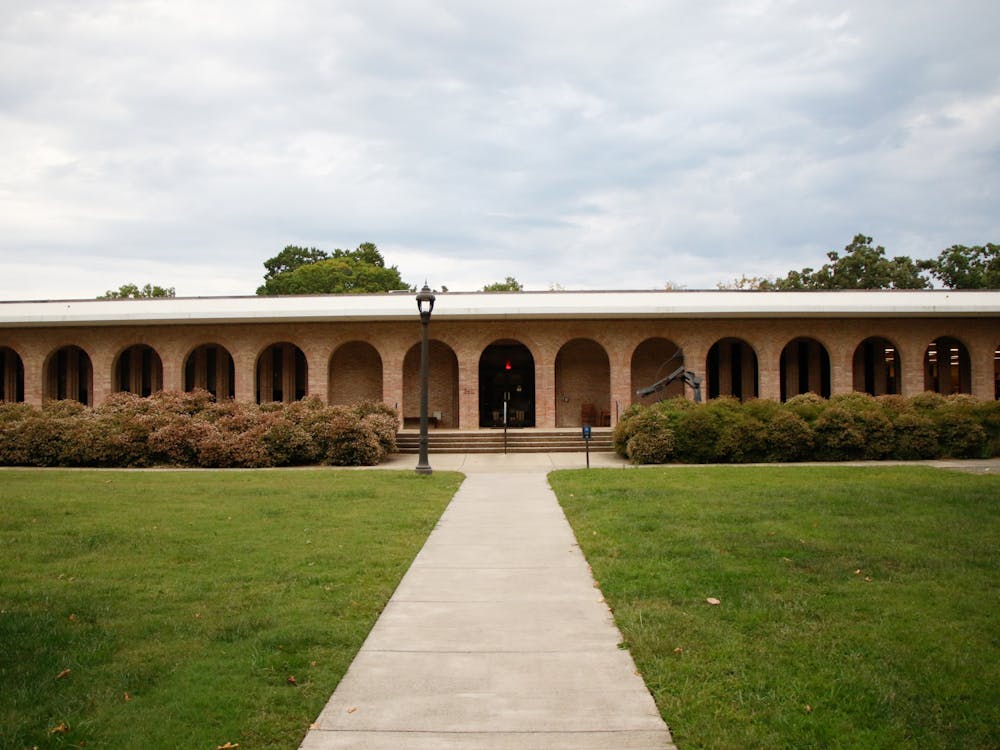In this story, I’ll be rating four of the major arts and performance venues at Duke using four criteria: location, function, architecture and accessibility. Location is everything about where and what the space is, including size and proximity to other sites. Function is about what the spot can be used for and if there are multiple ways to use it. Architecture related to a location’s style, appearance and inner structures and Accessibility is about if a site is easy to get to and use regardless of who you are. I’ll be using a letter-based ranking system to avoid the arbitrariness that can come with number rankings.
Mary Duke Biddle Music Building
Location: A-
Function: A
Architecture: A
Accessibility: A-
One major art spot on East is the Mary Duke Biddle Music Building, which also serves as the home to Duke’s Music Department and much of the Music Department’s facilities. It is named after Mary Duke Biddle (T’ 1907), daughter of Benjamin N. and Sarah P. Duke, who spent much of her life funding the arts and cultural community projects in Durham and New York City.
The Biddle Music Building has housed the Department of Music since its opening in 1974, containing several practice rooms and studios that are used by classes and various student groups. Today, the Biddle Music Building holds practice rooms of multiple functions perfectly suited for various instruments and a Music Library with over 100,000 items. Within the building, there is the Duke University Musical Instrument Collections (DUMIC), a great spot for classical instrument collectors. Lastly, the Biddle Music Building is home to rehearsal space Bone Hall and a fountain that is the site of regular fountain concerts.
Nelson Music Room
Location: A
Function: A
Architecture: A
Accessibility: B+
The Nelson Music Room is located on the second floor of East Duke Building, sharing the floor with the Department for International Comparative Studies. While not my highest in pure ranking, it is still my favorite music venue on East. The Nelson Music Room, with a capacity of 300, was initially a meeting place for the Columbian Literary Society - a Duke organization that started in 1846 at Duke’s predecessor the Union Institute before later dissolving. However, in the 1930s it took on a new life as an intimate acoustic recital room.
The aesthetics of the Nelson Music Room offers an intimacy between its exquisite design and the listeners – imagine watching the musicalization (and visualization) of Marguerite Duras’ works in this intimate space built with white pressed brick and Indiana sandstone – the audience connect themselves to literature and music as the lighting delicately undulates with notes flowed beneath fingertips and upon the bow.
Nelson Music Room is a limited space – a space that is limited and compressed often has tension in itself. In this room, we sit and see how music catalyzes the tension in the air through our feelings. This room is a perfect space to integrate and feel – not limited to its floor level or balcony.
Baldwin Auditorium
Location: A
Function: A+
Architecture: A
Get The Chronicle straight to your inbox
Sign up for our weekly newsletter. Cancel at any time.
Accessibility: A
Coming in first is Baldwin Auditorium which is situated at the end of East Campus’s main quad between Pegram and Basset, sitting right in front of the Baldwin Loop. Baldwin was previously known as the Woman’s College Auditorium – back when Duke had separate schools for men and women – before being renamed to honor former Dean of the Women’s College Alice Mary Baldwin. Baldwin Auditorium is an acoustic space primarily used for practice and formal performances. Compared to other performing venues on East, it is more of a traditional space for classical music performances. It is intricately decorated, with moldings and engravings covering much of the ceiling and walls.
A Georgian-styled building with Baltimore red pressed brick and Vermont marble, Baldwin Auditorium features two main seating levels that provide ample space for the audience, with wraparound balconies offering elevated points as unique perspectives of the performances. Baldwin Auditorium is perfect for performances that require little or no amplification, which includes classical soloists and ensembles, vocal ensembles and small jazz ensembles. In addition to holding large performances for student organizations such as Duke Symphony Orchestra, Duke Wind Symphony and Duke Chorale, Baldwin also regularly holds public concerts for Duke Arts’ Chamber Art Series, including the Emerson String Quartet’s farewell concert.
Duke Coffeehouse
Location: B+
Function: A
Architecture: A
Accessibility: B+
Duke Coffeehouse is a student-run music venue and study space that hosts artistic performances such as musical performance by local and touring musicians, film screenings and live poetry readings. Located in the back of Crowell Building (to access), Coffeehouse also offers free coffee, tea and snacks. Past shows invites include Japanese vocal performer Hatis Noit, the Brickside Music Festival, R&B singer and songwriter Grace Weber and DJ and artist Alice Longyu Gao – making it perfect for lovers of underground and/or indie-music scenes.
Tina Qian is a Trinity sophomore and an arts editor for Recess.

